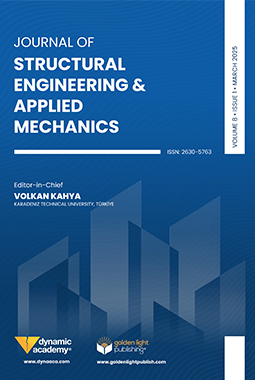ISSN:2630-5763
Journal of Structural Engineering & Applied Mechanics
ARTICLES
Haluk Görkem Alcan
Geopolymer concrete has recently attracted increasing attention as an alternative to traditional concrete due to its low carbon emissions and environmental friendliness. In addition, geopolymer concrete has great potential due to the use of industrial waste materials in its mixture and its high performance. The aim of this study is to experimentally investigate the effects of adding 0%, 10% and 20% silica fume instead of granulated blast furnace slag in the geopolymer mixture and 1% basalt fiber and polymer fiber addition on the performance of geopolymer concrete under high temperatures. In the study, both dry unit weight and water absorption rate for the evaluation of physical properties and compressive and flexural strength properties for the evaluation of mechanical performance were investigated in detail. 212 cube and 108 prism samples with dimensions of 50x50x50 mm and 40x40x160 mm were produced, respectively. Samples were exposed to temperatures of 20°C, 100°C, 200°C, and 400°C, and compressive strength, flexural strength, mass loss, and load-deflection curves were analyzed. The results obtained showed that although the temperature increased up to 100°C, causing the strength to increase by 25%, the strength of the samples decreased by 70% at a temperature of 400°C. In addition, it was observed that the strength of the samples decreased with the increase of the SF ratio in the mixtures, but the use of polymer fibers balanced the mentioned negative effect. These findings show that durable and sustainable building materials can be produced under high temperature conditions when the SF and fiber type are optimized together. The study contributes to the material design for applications requiring high temperature resistance.
https://doi.org/10.31462/jseam.2025.02049075
Kamran Samadi
Barış Güneş
Barış Sayın
This study numerically examines the impact of different soil classes on the seismic behavior of a high-rise RC building. For this purpose, a symmetric-plan, 30-story building model with reinforced concrete (RC) shear walls was prepared. The structural system of the model included two E-shaped core shear walls connected with coupling beams, forming a dual structural system consisting of core shear walls and a moment-resisting RC frame. Subsequently, earthquake parameters were obtained considering two different soil classes. Finally, modal response spectrum analysis was conducted considering two different response behaviors corresponding to upper (tower) and lower (podium) sections to determine the seismic performance level based on Turkish Building Earthquake Code (TBEC) 2018 conditions. Consequently, the relationship between soil class and seismic effects on the structural behavior of a high-rise building was established through a finite element model. The comparison of analysis results indicates that when transitioning from the ZB to the ZC local soil class, the maximum increase in axial load occurred in the corner columns, while the greatest increases in shear force were observed in the link beams and frame beams. Additionally, the highest shear force increases in the outer facade beams were also noted. Moreover, the bending moment transferred to the core shear walls nearly doubled, with the maximum bending moments in the core walls occurring at the transfer floor.
https://doi.org/10.31462/jseam.2025.02076102
Oğuzhan Akarsu
Abdulkadir Cüneyt Aydın
This study investigated the use of advanced machine learning (ML) techniques to enhance the prediction of axial load capacity in Concrete-Filled Double-Skin Steel Tubular (CFDST) columns. A dataset comprising 255 experimentally tested samples was employed to train and evaluate nine different regression algorithms, including the tree-based ensemble methods. Among these, the XGBoost model, optimized using the Hyperopt–TPE algorithm, demonstrated the highest predictive accuracy, with an R² of 0.9856 and RMSE of 195.70 kN. The model's interpretability was further strengthened using SHAP (SHapley Additive exPlanations) and PDP (Partial Dependence Plot) analyses, which identified outer diameter, inner and outer tube thicknesses, and concrete compressive strength as the most influential variables. Additionally, the performance of the XGBoost model was benchmarked against established design codes (ACI, EC4, and AISC), revealing its superior accuracy and robustness in capturing complex nonlinear interactions. The findings suggest that ML models, particularly when enhanced with interpretability frameworks, can complement and surpass traditional code-based approaches in structural capacity estimation, offering reliable, transparent, and efficient tools for engineering design and optimization. These results highlight the strong potential of the model for practical integration into structural engineering workflows, where accurate and explainable predictions are essential for safe and cost-effective design decisions.
https://doi.org/10.31462/jseam.2025.02103132
Zafer Yılmaz
Murat Günaydın
Fatih Yesevi Okur
Ertugrul Taciroğlu
This study evaluates the effectiveness of the Modal Participation Ratio (MPR) and Enhanced Modal Participation Ratio (EMPR) methods for damage localization, specifically in multi-story structures with combined story damage scenarios. The originality of this work lies in its combined use of numerical and experimental validation on the same four-story steel frame model, focusing on complex multi-damage conditions rather than single-story or simulation-only studies. MPR values were derived from dynamic responses of a finite element model of a steel frame, obtained through numerical simulations using randomized white noise acceleration, while EMPR values were derived from experimental tests conducted on the same steel frame model, utilizing ambient vibrations. Thirteen damage scenarios, including single-, two-, and three-story combinations, were investigated. The results show that damaged degrees of freedom consistently exhibit the highest ΔMPR values, and that combined damage scenarios often produce additive MPR patterns that aid in damage separation. First-story damage had the most dominant effect on overall MPR variation, occasionally reducing the visibility of higher-story damage. The findings confirm that both methods are reliable tools for structural health monitoring and damage identification, even in complex multi-damage configurations.
https://doi.org/10.31462/jseam.2025.02133151
Tarun Kansal
This paper seeks to formulate the fundamental governing equations for an anisotropic thermoelastic medium distinguished by triple porosity, microtemperatures, and microconcentrations. The model proposed in this study integrates the influences of porosity, microtemperatures, and microconcentrations, crucial factors in providing a precise description of material behavior. Additionally, the objective is to develop the fundamental solution for the system of equations corresponding to steady oscillations and equilibrium conditions.
https://doi.org/10.31462/jseam.2025.02152174


